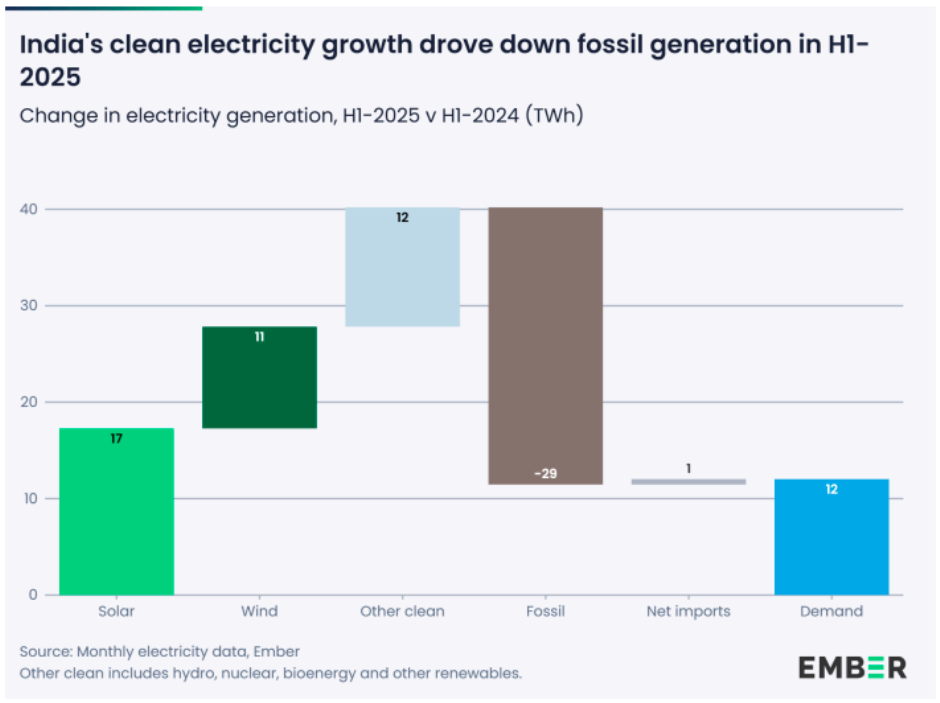India, the world’s third-largest electricity consumer, accounted for 6.2 percent of global electricity demand and 9.1 percent of global CO₂ emissions in the first half of 2025. Yet, in a major step toward a cleaner energy future, the country saw growth in renewable and low-carbon sources outpace electricity demand by more than three times, driven by record additions in solar and wind power. This clean energy surge, combined with milder weather and fewer heatwaves, reduced both coal generation and power sector emissions.
Clean Energy Outpaces Demand Amid Milder Weather
Electricity demand in India grew modestly by 12 TWh (1.3 percent) in H1 2025 — the lowest growth since the COVID-19 pandemic, compared with a strong 75 TWh (9 percent) increase during the same period last year. The slowdown was largely due to moderate industrial activity and fewer heatwaves, which lowered air-conditioning demand, according to new analysis from Ember.
According to estimates, air conditioning accounts for nearly 50 GW, or 20 percent, of India’s peak power load. Ember’s analysis suggests that if temperatures in April, May, and June had been similar to 2024, demand would have risen by around 3.5 percent (+32 TWh). Even under that scenario, renewable generation growth—led by solar and wind—would still have exceeded demand, rising by 40 TWh (20 percent) and continuing to push down coal generation.
Electricity demand is, however, expected to rebound in the second half of 2025, particularly as economic activity accelerates, likely leading to higher coal generation in the short term.
Record Growth in Solar and Wind Power
India’s renewable energy transition gained significant momentum in 2025, with solar and wind generation reaching record highs.
Solar energy generation rose by 17 TWh (25 percent), more than double the 8 TWh (13 percent) increase recorded a year earlier. This lifted solar’s share in India’s electricity mix to 9.2 percent, up from 7.4 percent in the first half of 2024.
Wind power also surged, growing by 11 TWh (29 percent), compared to a mere 0.5 TWh (1.3 percent) increase last year. Wind’s share of the mix climbed to 5.1 percent from 4 percent. Notably, the rise in solar generation alone exceeded the entire increase in electricity demand, while the combined growth in wind and hydro generation nearly matched total demand growth.
Other Low-Carbon Sources Strengthen
Other clean sources also contributed to India’s low-carbon gains. Nuclear generation increased by 3.5 TWh (14 percent), slightly higher than the 2.6 TWh (12 percent) increase last year. Hydropower rebounded strongly, adding 9.6 TWh (17 percent), reversing the 4.9 TWh (7.8 percent) decline in H1 2024.
This widespread expansion of clean sources significantly reduced fossil fuel dependence. Coal generation fell by 22 TWh (3.1 percent), while gas generation plunged by 7.1 TWh (34 percent). Consequently, India’s power sector CO₂ emissions dropped by 24 MtCO₂ (3.6 percent) compared with the same period last year.
India’s Energy Transition Gains Momentum
India’s clean energy growth in 2025 underscores its progress toward meeting its renewable energy and climate targets, supported by record solar and wind additions, improved hydro output, and strong nuclear growth. With electricity demand expected to accelerate in the second half of the year, the key challenge will be maintaining the pace of renewable expansion to sustain the downward trend in coal generation and emissions.
India’s performance in H1 2025 highlights that rapid renewable energy deployment, coupled with favorable weather and efficient demand management, can deliver both energy security and emissions reduction — a critical step on the nation’s path toward net-zero ambitions.
Baburajan Kizhakedath

